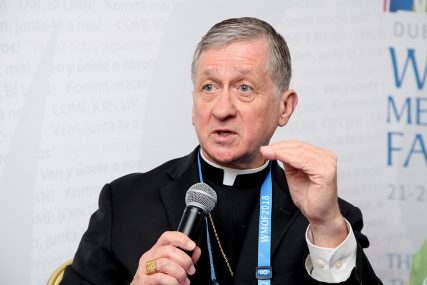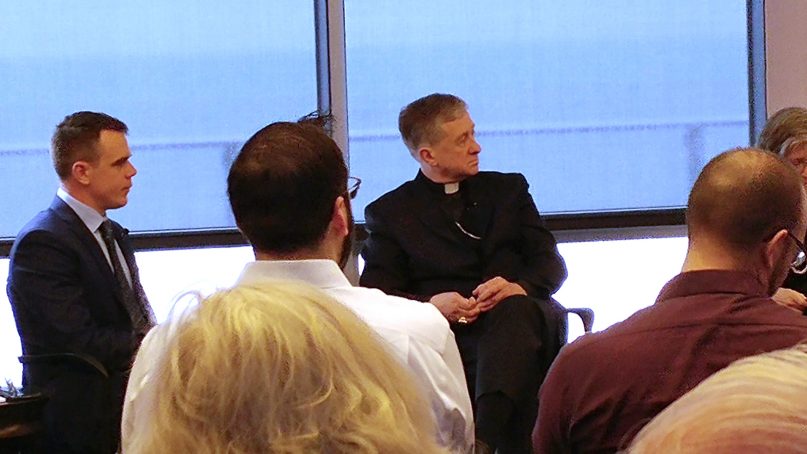CHICAGO (RNS) — “We’re not a church with a mission, we’re a mission with a church,” Cardinal Blase Cupich told the folks who showed up at Loyola University of Chicago last Thursday evening (April 4) to hear their archbishop talk with a couple of academics and a journalist about the future of Catholicism in America.
It was a subtle and clever remark, not least because “mission” as a religious term originates with the Jesuits, who were sent (Lat. missi) to the ends of the Earth “for the greater glory of God and the salvation of human beings,” as their co-founder, Ignatius Loyola, put it.
The cardinal’s point was that the mission is more important than the church, and perhaps also that the mission remains as compelling as ever even as the church is going through a rough time. Over the past year the sexual abuse crisis has become as international as the Jesuit order, while in America, the church has been riven by bitter ideological combat between progressives and traditionalists.
Cupich himself belongs to the progressive party of Francis, the first Jesuit pope, who promoted him from the small diocese of Spokane to one of the country’s great sees, gave him his red hat and, most recently, charged him with organizing February’s meeting on sexual abuse for the heads of all the bishops’ conferences in the world. This has placed a target on his back.

Cardinal Blase Cupich, Archbishop of Chicago, at a press briefing at the Pastoral Congress for the World Meeting of Families in Dublin on Aug. 23, 2018. Photo by John McElroy on behalf of WMOF 2018
“Catholic Watchdog: Cupich Worse Than Any Criminal” ran the headline on the anti-Francis website Church Militant last week, for example.
So what is the future of Catholicism in America? On Friday, Loyola’s Hank Center for the Catholic Intellectual Heritage hosted a small conference to consider the conclusions of a new book on the subject that, full disclosure, I co-edited.
A good deal of what Catholicism faces in this country is what religion as a whole faces. More and more Americans are disclaiming any religious identity: Nones have grown from a single-digit percentage of the adult population three decades ago to a quarter of it now. And religious identity is increasingly seen as a matter of personal choice rather than inheritance and upbringing — with less and less regard for those vested with religious authority.
These developments pose different kinds of challenges for different traditions. In America, the Catholic Church for a long time depended heavily on ascribed identity based in ethnicity. Today, Latino Catholic identity is proving less durable than Irish, Italian and Polish Catholic identities once were.
Then there are women, historically the mainstay of the American church, but increasingly put out with second class citizenship in a world where men rule the roost. According to the the most recent data, young Catholic women are disproportionately voting with their feet. “Why are millennial women leaving?” asked Kathleen McNutt, a Ph.D. student in theology at Loyola. “Sometimes it’s death by a thousand paper cuts.”
The sexual abuse crisis, now rolling into its fourth decade, has steepened the trajectory of demographic decline.
“Much of the research, since Vatican II, has been focused on the question of Catholic identity,” said William Dinges, a historian who teaches at the Catholic University of America. “Now, in light of the scandal, there is a shift from ‘who is a Catholic?’ to ‘why be Catholic?'”
Fifty years ago the Second Vatican Council demonstrated that Catholic teachings were not fixed for all time, leaving the faithful with a sense that they could take a more relaxed view of what the church had to say about, for instance, birth control. Meanwhile, conservatives who once accused progressives of being “cafeteria Catholics” nowadays themselves decide which social teachings of the magisterium they wish to embrace: opposition to abortion and same-sex marriage by all means, opposition to the death penalty and immigration restriction not so much.
The old saw used to be “Rome has spoken, case closed.” Now, when the pope opens the door to Communion for the divorced and remarried, a traditionalist chorus declares he has no right to do so.
Such diversity in policy and doctrinal preference is mirrored in worship, where a wide variety of styles and approaches are widely accepted. With the Vatican’s sanctioning of the old-time Latin Mass, even traditionalists have come to believe that being able to do your own liturgical thing isn’t such a bad thing.
Joseph Chinnici, a historian and president emeritus of Franciscan School of Theology in California, argued the thesis that the future of Catholicism will be ineluctably pluriform: different things to different people. To be sure, that won’t mean that certain central beliefs and practices won’t continue to exert gravitational force, and certain central issues won’t continue to be embraced, and fought over. “A Pluriform Unity” is the title of his chapter.
The American Catholic community of the future will be pluriform, and if not smaller in numbers than it is now, almost certainly a shrinking portion of the population at large. But can the hierarchy deal with a community of the faithful who insist on choosing the Catholicism that makes sense to them?
“It scares the bejeebers out of church people,” said Cupich. “But I welcome that dialogue.”






